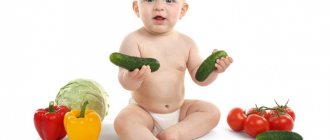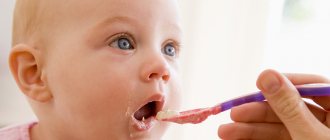The child is 9 months old. What can he do? Quickly crawls in different directions, climbs on all fours onto a pillow, elevation, or the ladder of a children's slide. Typically, physical development allows a child at 9 months to sit up from a lying position and lie down from a sitting position. At this age, the baby often already kneels, stands on his feet, holding onto a support (rises from a sitting position) and even jumps, holding onto a barrier. At 9 months, a child can stand with support from one hand and step with support on both hands or under the armpits, as well as move with an extended step, holding onto a support. A 9-month-old child is able to repeat the movements of an adult: raising, lowering his hands, patting.
Height and weight of a child at 9 months, data from domestic pediatricians
| 9 months | Bottom line | Upper limit |
| Boys' weight, kg | 7,9 | 10,5 |
| Girls' weight, kg | 7,5 | 9,7 |
| Boys' height, cm | 68,2 | 75,1 |
| Girls' height, cm | 67,5 | 74,1 |
| Boys' head circumference, cm | 44,0 | 47,4 |
| Head circumference of girls, cm | 42,9 | 46,4 |
| Boys chest circumference, cm | 44,4 | 50,8 |
| Girls chest circumference, cm | 44,5 | 49,3 |
What a child should be able to do at 9 months: Komarovsky’s opinion
The well-known Russian pediatrician, Candidate of Medical Sciences, Evgeniy Olegovich Komarovsky considers developed hearing, the ability to recognize familiar people, and interest in toys of different colors and textures to be the main indicators of the normal development of a nine-month-old child.
At the age of 9 months, the doctor recommends starting the socialization of the baby: parents can bring the child to the playground so that he gradually learns to interact with the team.
For the rest, Evgeniy Olegovich advises not to chase the average standards and achievements of neighboring children. Komarovsky is of the opinion that each baby develops at an individual pace that is right for him.
Height and weight of children aged 9 months WHO data
| 9 months | Bottom line | Upper limit |
| Boys' weight, kg | 7,1 | 11,0 |
| Girls' weight, kg | 6,5 | 10,5 |
| Boys' height, cm | 67,5 | 76,5 |
| Girls' height, cm | 65,3 | 75,0 |
| Boys' head circumference, cm | 42,5 | 47,5 |
| Head circumference of girls, cm | 41,2 | 46,5 |
What else should a child aged 1 year and 9 months be able to do?
The baby can drink and eat independently using a spoon or fork. He can also undress or wash his hands.
Child development in the second year of life also includes the acquisition of certain imitative skills. At this age, your child will probably be able to hug and stroke a crying doll, treating it the same way adults treat their children.
This is the time when the child begins to speak better and better. The two-year development of speech is systematic; he learns new words and tries to put them into short sentences.
The child is already beginning to realize that he is a separate person - this is manifested in the fact that he can notice and show himself in the mirror, recognize him in a photo or video.
A two-year-old child is active, which means that his parents must be very careful and take care of his safety.
Skills of a child from 1 year and 9 months to 2 years:
- Runs, jumps, climbs stairs with a little help, sits down and gets up from a chair.
- Can arrange objects in a row, move toys, arrange them.
- Doodles or pretends to draw.
- Drinks from a cup, holds a spoon, uses a fork.
- Understands and follows complex commands such as “go to the kitchen and get your cup.”
- Knows the names of most objects that surround him.
- Uses dozens of words and combines them into short, simple sentences.
- Knows and uses certain social actions, such as shaking hands.
- Imitates simple actions seen before.
An important skill to develop is “showing off” or attracting attention; a child can put a lot of effort into getting adults to look only at him.
The baby can also express his desires using simplified words, facial expressions and gestures. Some sources say that children around 2 years of age can use up to 200-500 words.
At this time, sensory-motor intelligence develops - the child learns about the world through feelings and movements.
Child growth from 1 year and 9 months to 2 years - norms for boys and girls
Child growth during this period, according to WHO:
- Girls: from 83.8 to 87.0 cm.
- Boys: from 85.0 to 88.1 cm.
Child weight from 1 year and 9 months to 2 years - norms for boys and girls
- Girls: from 10.5 to 12.2 kg.
- Boys: from 11.3 to 13.0 kg.
At this time, further intensive psychomotor development of the baby occurs, although physical development is no longer as dynamic as in the first year. A slowdown in weight gain is observed with continued rapid growth, body proportions change - the child’s figure becomes thinner.
Cognitive development of a child at 9 months
A 9-month-old child examines his reflection in the mirror with interest. Takes a toy from the hands of an adult, holds it in his fist, examines it (or licks it). Imitating an adult or independently waving, rattling, knocking with a toy.
At 9 months, the child develops a so-called tweezer grip: now he increasingly grasps an object not with his palm, but with two fingers - the thumb and forefinger. Actions with small objects are being improved: a 9-month-old baby takes them out (pours them out) and puts them back into the container, and also opens (removes) the lids. At the age of 9 months, a child can operate two toys simultaneously, holding one toy in each hand.
What can a 9 month old baby do?
Vision
Actively observes adults, responds adequately to facial expressions and gestures of adults
Hearing
Learns to perform more complex actions at the request of adults - “kiss mom”, “give me a pen”, “look”, “where”, etc. Remembers the names of adults well. Responds to his name. Says the first words.
Speech
Chains of syllables appear in speech - “ma-ma-ma”, “ba-ba-ba”, etc. During this period, children begin to pronounce new sound combinations, understand and respond to simple requests
Motor skills
He sits down well on his own and sits without support. Stands on his feet and moves with support, confidently stands on all fours, crawls, moving alternately his right arm and leg, then his left, grabs small objects with two or three fingers. While sitting, he takes toys. Confidently takes objects and finds toys.
Emotions
He communicates with gestures, reacts vigorously and joyfully to his mother and those closest to him. Begins to clearly demonstrate emotions. If they try to take away a toy that interests him, he begins to get offended and cry loudly. If something doesn't work out, get angry. The child’s actions become purposeful, he begins to realize that he can get results in response to his actions. The child begins to imitate the emotions and behavior of adults, become interested in new games, and smile at his reflection in the mirror. A game. Plays with several objects, knocks them together, looks for hidden things, loves to play with musical instruments.
These child development skills at 9 months are only indicative. If your child doesn’t know how to do something, don’t sound the alarm. All children acquire new knowledge and learn about the world at different paces.
Emotional and social development of a 9 month old baby
A child of 9 months is the blossoming of objective activity with toys and the very beginning of social contacts. At this age, the baby already shows a special interest in some toys (gives preference to them). Smiles in response to the result of a successful action (opened the box). Enjoys fun games with adults and dance movements. Shows interest in children and their play. A baby at the age of 9 months (or a little earlier or later) appears a specific facial expression in different situations: interest, pleasure, joy, attention, resentment.
Daily routine at 9 months
For the full development of a nine-month-old child, the daily routine, proper nutrition, communication, and educational games are of great importance. Failure to comply with the routine negatively affects the physical and psychological state of the child, he becomes capricious. In addition, following a number of specific rules helps the baby navigate time. Below is an approximate daily routine that promotes the harmonious development of a child at 9 months.
| Time | Action |
| 7.30-8.00 | Getting up, first meal. When feeding your baby for the first time, it is better to give breast milk or adapted infant formula. |
| 8. 00-8.30 | Water treatments |
| 8.30-9.30 | Educational games with a child |
| 9.30-10.30 | Gymnastics, massage |
| 10.30-11.30 | Second meal |
| 11.30-14.30 | Walk in the fresh air, nap |
| 14.30-15.30 | Feeding |
| 15.30-16.30 | Educational games |
| 16.30-19.00 | Walk, sleep |
| 19.00-19.30 | Feeding |
| 19.30-21.30 | Educational games |
| 21.30-22.00 | Water procedures, preparation for bed |
| 22.00-22.30 | Feeding, putting to bed |
Sleeping mode
For the full development of a child at 9 months, proper rest is necessary. At this age, the baby sleeps approximately 12-15 hours. Sleep at night accounts for 9-11 hours, while daytime sleep time is reduced to three to four hours. To prevent your child from having problems falling asleep, follow these recommendations:
- Follow a daily routine;
- Avoid active games before bedtime;
- Create suitable conditions for sleep (silence, absence of bright light, cool, ventilated room, humidified air);
- Ensure your child is sufficiently active while awake.
Nutrition
For normal development, a 9-month-old child needs to eat properly. By this age, the baby receives the lion's share of nutrients from complementary foods. Breast milk or formula is recommended to be given upon waking and before bed. For full development, the baby’s diet must contain the following products:
- Cottage cheese up to 50 g;
- Vegetables (broccoli, zucchini, pumpkin, carrots, potatoes, beets, cabbage) up to 200g;
- Porridge (buckwheat, rice, wheat, corn, barley) up to 200g;
- Juice up to 90g;
- Egg yolk 0.5 pcs.
At this age, low-fat varieties of white fish can be introduced (up to 30 grams per day). Fish is given no more than two or three times a week. When introducing it into complementary foods, you need to control the body's reaction, as it can cause allergies.
Meat should be given finely chopped, in the form of meatballs or as part of soups. Experts recommend preparing a child’s diet so that one serving is about 200 ml (drinking is not taken into account).
Speech development of a child at 9 months
Speech understanding:
Hearing his name, he turns and crawls over. To the question: “Where is it?” turns and looks towards the named object (familiar). At the request of an adult, he looks at one of the three toys standing nearby. He takes (hands to the adult) a toy named several times (“Give me this”). At 9 months, the child understands the words: “lie down”, “get up”, “throw”, “on” and others, knows the purpose of individual objects: cup, spoon, bottle, comb. A 9-month-old baby can listen for a long time to the speech of an adult (not addressed to him) and observe the movements of the adult’s lips.
Active reproduction of speech sounds:
A child of 9 months can repeat syllables and sounds from his babble after an adult, and also imitate expressive sounds (in his own way): “sneezes,” “snorts,” “buzzes,” “barks,” “meows.” At this age, the baby babbles loudly during periods of wakefulness.
Norms of weight and height for a child at 9 months
A child at this age, on average, gains 300-500g in weight and 1-2 cm in height.
| Indicators | Development in girls at 9 months | Development in boys at 9 months |
| Weight | 7.3 kg - 9.9 kg | 7.2 kg - 9.6 kg |
| Height | 68 cm - 74 cm | 66 cm - 72 cm |
Caring for a 9 month old baby
The child is now so mobile that he will constantly find new objects that he can pick up, throw or try to take apart.
Make sure that the space in which the baby is located is absolutely safe.
Caring for a 9-month-old child – without any special features or peculiarities. It is also necessary to pay attention to the baby's hygiene, especially before changing the diaper. Full bathing with soap products is recommended no more than twice a week. If the little one likes being in the bath, it is allowed to have daily water treatments before dinner (without soap and shampoos).
At this age, parents begin to think about purchasing a walker; they think that this way the child will learn to walk quickly and correctly. The opinions of experts about such a product cannot be called unambiguous.
However, most experts argue that walkers can cause some harm to the child’s musculoskeletal system if he has not yet learned to hold his back straight.
Even the most expensive and high-quality walkers will create additional stress on the spine, causing its curvature in the future.
In addition, using such a device will not teach the child balance. In a walker, he would rather hang than stand upright. This will result in the child having difficulty learning to walk independently by 12 months. Also, some experts note an increased risk of developing flat feet.











